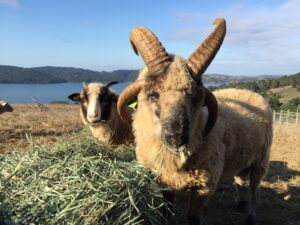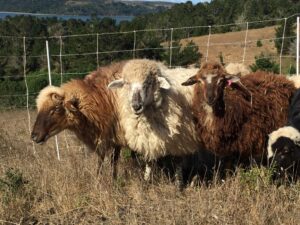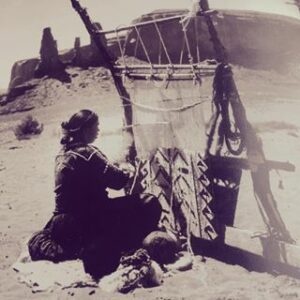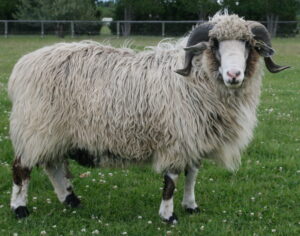We believe heritage breeds are an important part of our country’s agricultural history. Establishing a quality breeding program benefits the genetics of a rare breed and connects you to other breeders for selling (or trading) good stock. Animals that don’t make the grade for reproducing can be harvested and sold as delicious food to customers.
Navajo-Churro Sheep
The Navajo-Churro sheep is a great example of a heritage breed with many wonderful attributes for the small or large farm. They are a regal, lean, and long-legged sheep that come in a range of colors and patterns. They grow up to 12 inches of double-coated wool per year. They are resistant to disease and parasites, adventurous browsers, tolerant of extremes in temperature and drought conditions, superior mothers, alert, social, and intelligent. They can be polled or multi-horned. Last but not least, they taste exquisite. The meat is refined and subtle, delicately perfumed with the scent of lamb.
The Navajo-Churro is also a historic animal. The sheep were first brought to the Caribbean and Mexico by the Spaniards in 1494. They were well-established in the American Southwest by the late 1500s. The Navajo people embraced shepherding and incorporated the sheep into their culture for wool and meat. Keeping livestock and weaving textiles became a foundational element of the Navajo lifeway. “Sheep Is Life” is a belief system as well as a continuing annual celebration (held in Tsaile, Arizona) of traditional Navajo shepherding and weaving culture.
Brutal slaughter of sheep and other livestock took place at the hands of the U.S. government during the “Long Walk” era of forced resettlement. Mass slaughter and enforced cross-breeding continued through the 1940s. These measures among other travesties served to oppress the Navajo people, by “disrupting the chain connecting Navajo culture, weaving, traditional lifestyle, and self-sufficiency.” The decimation of family herds and the abuse inflicted by our government are wounds that are still very much open in the present. “Today, elders tearfully recall that time and can describe in detail each sheep that was killed and the exact location of the massacre.” (Both quotes from Diné be ‘iiná’s “Short History on Navajo-Churro Sheep.”)
Despite an aggressive effort to drive the Navajo-Churro into extinction, small flocks of “old type” sheep survived in isolated pockets of the Southwest. Over time numbers dwindled, some say to less than 500. In 1977 an organization called the Navajo Sheep Project began collaborating with many dedicated individuals to increase the sheep population on and off the Navajo Nation. In 1986 the Navajo-Churro Sheep Association started registering sheep based on a set of phenotypic standards (or breed characteristics) to help breeders conform their flocks to “type” and register animals with limited or no pedigree information. The sheep population now has a registry in the thousands but is still listed as “threatened” by The Livestock Conservancy.
For more on Navajo history and culture I have compiled a bibliography of resources.
We are active members of the Navajo-Churro Sheep Association and breed for high quality registered stock. Farms and shepherds we are pleased to have acquired stock from include Bide-A-Wee Farm, McKenzie Creek Ranch, Spin Dance Acres, Where the Sun Rises Farm, Bradford Ranch, Jay’s Navajo-Churro Lamb & Wool, Coppermine Navajo-Churro Sheep, Nizhoni Heritage Farms, Robbin Robinson, Irma Henderson, Lorena Noelson, Mary Begay, and Dot Ranch.
Our modern food system has consolidated into livestock breeds that can survive in production environments and generate maximum profit. This has resulted in a decrease in the diversity of foods we have available to us and the gradual phasing out of once-popular livestock species. This is an unfortunate consequence and an obvious detriment to small farmers. Animals are naturally adapted to geographic locations and environmental conditions. Nurturing so-called “heritage” livestock species allows us to select hardier and more well-adapted animals specific to our location. It also gives us a way to differentiate our products from what is typically available in the marketplace.
Supporting heritage breeds and the small farms that raise them gives livestock animals a chance at a better life under more natural conditions. Admittedly the complexity of feeding our enormous population is daunting. For those who have the luxury of choice buying direct from farms and “eating local” is one way to lead a more responsible life. Contact us for more information about purchasing a lamb share.



